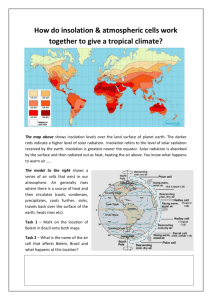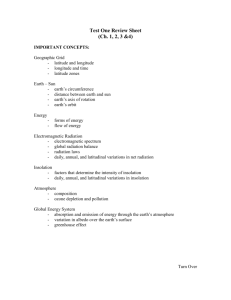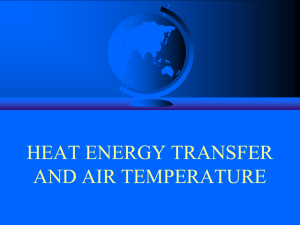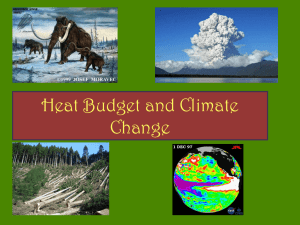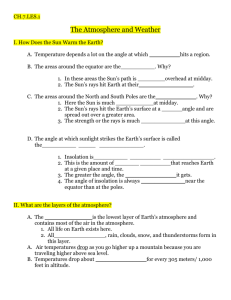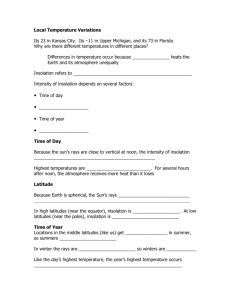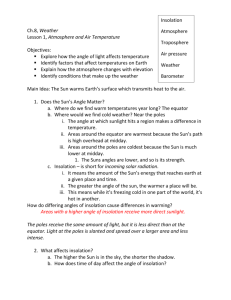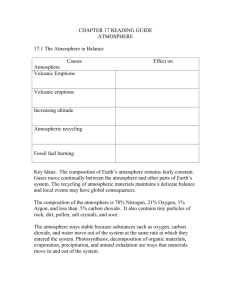ATMOSPHERE
advertisement
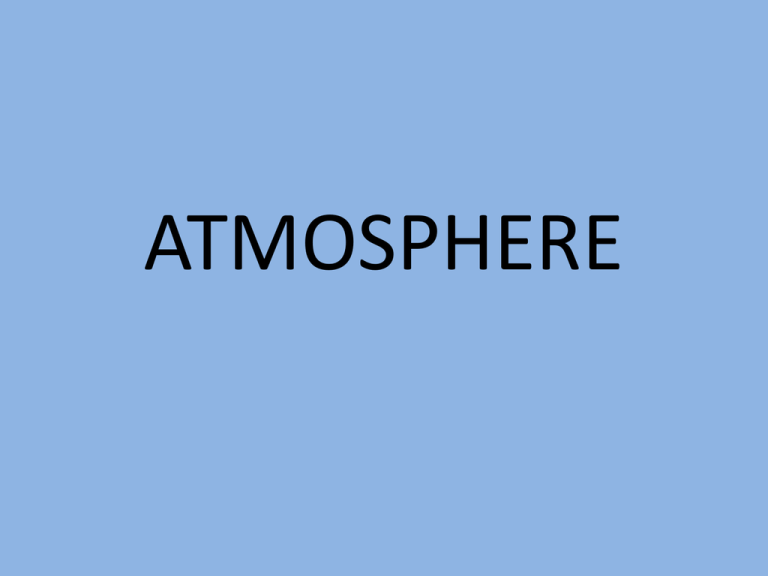
ATMOSPHERE Composition of the Atmosphere •The atmosphere is comprised of a variety of gases: Major Constituents (99%): Nitrogen (N): 78% Oxygen (O2): 21% Trace Constituents: Argon (Ar), about 0.9% Water vapor (H2O), Carbon dioxide (CO2), Ozone (O3), near zero at the surface Methane (CH4), and others….. Recycling of Atmospheric Materials Movement of Heat Energy • Radiation: the transfer of energy through space in the form of visible light, ultraviolet rays and other types of electromagnetic waves. • Convection: the transfer of heat energy in a liquid or gas through the motion of the liquid or gas caused by differences in density. • Conduction: the transfer of heat energy through collisions of the atoms or molecules of a substance. Heat and Temperature • Temperature: is a measure of the average kinetic energy of atoms or molecules in the substance. • Heat: the total kinetic energy of all of the particles of the substance. Troposphere: • 0 to 15 km altitude • The lowest region of the atmosphere, where life & weather exist. • It contains 99 percent of the water vapor and 75 percent of the atmospheric gases • Temperature decreases with altitude. • Long-wave radiation emitted from Earth is absorbed by the atmosphere, the atmosphere becomes less dense with increasing altitude, less air to absorb • Top of the troposphere is known as the tropopause Stratosphere • 15 to 50 km altitude • Heating occurs because ozone (O3) absorbs ultraviolet radiation from the Sun. • Temperature increases with altitude due to ozone absorbing ultraviolet radiation. • Top of the stratosphere is known as the stratopause Mesosphere • 50 to 90 km altitude • Temperature decreases with altitude • The lowest temperatures in the entire atmosphere are found at the mesopause during summer at high latitudes, 130 K (-226°F) can occur • Top of the mesosphere is known as the mesopause Thermosphere • 90 to 500 km altitude • Temperature increases with altitude above 90 km, and is constant above 200 km. • This heating is due to absorption of solar radiation. • The highest temperatures in the atmosphere can be found in the thermosphere, can rise about 1000oC (2000 K) • Separated into layers of different gasses. • Lowest layer Nitrogen • Then Oxygen to 1000km • Then Helium to 2400km • Top layer is Hydrogen thinning into space Ionosphere: • Occurs within the mesosphere and thermosphere between 90 and 500 km. • Layer of electrically charged particles • Effected by solar events • Electrically charged particles for solar events interact with Earth’s magnetic field create auroras (Northern and Southern lights). Exosphere: • The exosphere is the outermost layer of the atmosphere. • The temperature in the exosphere goes up with altitude. • Satellites orbit earth in the exosphere Insolation and the Atmosphere • Insolation: incoming solar radiation. – some solar radiation is absorbed by gasses in the atmosphere – some solar radiation reaches the Earth’s surface – some solar radiation is scattered in the atmosphere and is returned to space Heat Budget of Earth and the Atmosphere • Small % of insolation is absorbed by the atmosphere. • Energy transferred by radiation, conduction and evaporation and substance condesation of water • This energy transfer is the major cause of Earth’s weather • 50% of solar radiation reaches the Earth’s surface • Accumulation of carbon dioxide and water vapor absorbs most of the infrared radiation preventing from radiating directly back into space creating the Greenhouse effect. • Without the green house effect, most of the heat energy would be lost to outer space, which would cause Earth’s average temperate to be about 33oC. • The increased levels of carbon dioxide in the atmosphere the Earth’s heat budget may be out of balance, thus the warnings of Global Warming. Temperature variations due to Insolation • The intensity of insolation varies with the time of day, the latitude and the time of year. • The characteristics of a material determines how much insolation is absorbed and how the absorbed energy affects the temperature. Intensity of Insolation • Intensity of insolation is depended on the angle at which the sun’s rays strike Earth’s surface. • When the sun is at 90o the Earth receives the maximum amount of energy. • As the angle of insolation decreases the amount of energy decreases because the energy of the rays are spread over a larger area. • The sun ray’s are closest to 90o at noon, the intensity of insolation is the greatest, so Earth’s sufaces heats up more quickly • However, the warmest temperatures of the day are usually a several hours after noon, when the lower atmosphere is receiving more energy from the ground than it loses. • The coolest temperatures of the day are right before dawn when both the ground and the atmosphere has lost most of its heat. Intensity of Insolation • The intensity of insolation is affected by the latitude. • The closer to the equator the sun’s rays are almost vertical, so the hotter the climate. • Moving either north or south of the equator the angle of insolation increases so the energy is spread out over a larger area. Thus the greater the latitude the colder the climate. Intensity of Insolation • At mid-latitudes, the sun ray’s are nearly vertical in the summer so summers are hot. During the winter the angle of insolation is greater so the winters are cold. • Like day’s maximum tempertures,the year’s highest temperatures after the time of maximum insolation. • In the Northern Hemisphere, the lowest angle of insolation occurs around Jun 21, so July is the warmest month of the year. The greatest angle of insolation occurs in around December 21, so January is the coldest month. • The Southern Hemisphere is the reverse. • The affect of the insolation on sea-level temperatures in January and July. • What changes do you notice? Human Impact on the Atmosphere Acid Rain • Forms due to pollutants such as sulfur dioxide and nitrogen dioxide react with water vapor. • Acidity is measured by pH. The lower the pH the more acidic the rain. Smog • Temperature inversion: when the temperature at the Earth’s surface is cooler than the air above it, so convection does not occur Ozone Depletion • Hole in Ozone layer due to pollution of chloroflurocarbons (CFCs). • Has greatly be reduce due to the elimination of CFCs. • Thin Ozone/Hole forms each spring over Antarctica. • Thinning Ozone/hole allows for exposure to ultraviolent radiation which is dangerous to living things.
